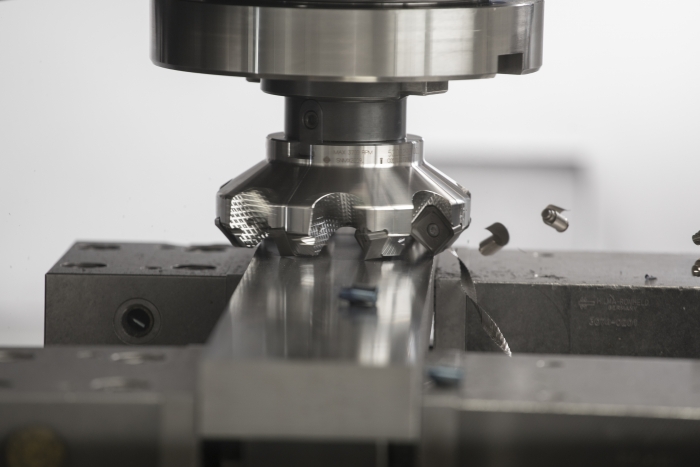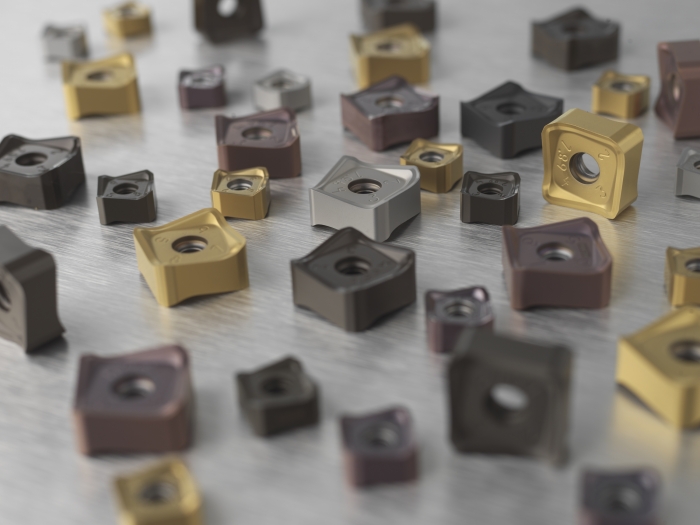Article from Seco Tools LLC
Almost every machine shop uses facemills for roughing, semifinishing and finishing, but many of these shops miss out on increased material-removal rates because they run yesterday’s tooling on today’s machine tools. The larger spindle tapers and higher horsepower ratings, feeds and speeds of modern machines need to run with the latest in facemilling cutter and insert technology to maximize a machine’s facemilling potential and thus significantly speed up production, increase efficiency and reduce cost per part, especially on larger workpieces.
The latest facemilling cutters incorporate a new generation of multiple-sided, multiple-edged insert options – inserts with free cutting capability – that help optimize current machine tool performance. These insert geometries increase tool life, reduce cutting forces and produce chips with the open formation that reduces cutting edge stress.
Shops gain the ability to facemill with less force and take full advantage of their machine tool spindles' capabilities through increased cutting widths, depths and/or feed rates. The key to these performance advantages lies in using the right lead and rake angles. When cutting tool supplier Seco Tools developed its latest Double Quattromill 22 and 14 facemilling cutters, for example, it opted for dual lead angles of 45° and 68° cutter bodies.

A 45° lead angle on the Double Quattromill 22 produces better chip thinning, higher feed rates and more bidirectional cutting forces.
These dual lead angles accommodate medium to large DOCs and enable shops to choose the cutting force options that best suit their individual workflows. A 45° lead angle on the Double Quattromill 22, for instance, produces better chip thinning, higher feed rates and more bidirectional cutting forces, all attributes that suit situations with unstable or weak fixturing. The 68° lead angle of the Double Quattromill produces higher DOC capabilities within the same inscribed circle diameter. Its chip thinning performance improves on 90° lead angles while it offers greater ability to avoid sidewalls or fixturing than a 45° lead angle.
Cutter geometry largely determines facemill performance. Highly positive geometries produce free and easy cutting, even with double-sided edges. Along with lead angles, axial (GAMP) and radial (GAMF) rake angles influence cutter behavior. The combination of negative axial and radial rake produces strong cutting-edge geometry and high productivity, able to accommodate heavy feed rates, interrupted cuts and other difficult machining procedures – all necessities with large, heavy-duty spindle tapers and rigid fixturing. With the correct choice of insert geometry, however, these same cutters work well with machines that offer lower horsepower levels. Because of these advantages, Seco Tools designed the Double Quattromill 22 and Double Quattromill 14 with negative axial and radial rakes.

To make the Double Quattromill 22 and Double Quattromill 14 applicable to a broad range of applications, Seco Tools offers three choices of insert geometries.
Insert geometry options further enable shops to specify their facemills and inserts to match their workflows. To make the Double Quattromill 22 and Double Quattromill 14 applicable to a broad range of applications, Seco Tools offers three choices of insert geometries. Double Quattromill 22 includes ME12, M12 and M18 while Double Quattromill 14 uses ME10, M10 and M16. These geometries boast capabilities that lend themselves to working with specific types of machine tools and materials.
ME12 and ME10 provide a sharp edge that creates lower cutting forces than M12, M10, M18 and M16. As a result, ME12 and ME10 work well with lower horsepower levels, and are well suited for sticky materials such as titanium and stainless steel.
M12 and M10 have sharper edges and smaller T lands that create less cutting force than M18 or M16. This reduced force excels at lower spindle horsepower levels, while the M12 and M10 do well with sticky materials, some tool steels and superalloys.
M18 and M16 provide the best edge protection when machining abrasive materials. These geometries are well suited to steels, tool steels and cast irons.
For modern equipment with less horsepower but with strong, efficient performance, Seco Tools designed the Double Quattromill 14 as a smaller cutter for machines that don't develop average chip thickness or run the aggressive feeds of their larger siblings – the overwhelming percentage of the modern machines in current use, many of which can't make full use of bigger facemills such as the Double Quattromill 22.
Cutting edges only function properly when inserts fit and lock securely into cutter bodies, especially when it comes to multiple double-sided insert cutting edges. With typical wedge clamping systems, inserts can move or shift under the substantial forces of aggressive feed rates and cutting depths. Conversely, the center locking screws of Seco’s Double Quattromill cutters ensure mounting security for both fixed-pocket and cassette-style bodies.
With performance that matches today's equipment and a range of options relevant to the industries that will use these facemills, the Double Quattromill 22 and Double Quattromill 14 optimize the face milling performance of any spindle.
Contact Details
Related Glossary Terms
- abrasive
abrasive
Substance used for grinding, honing, lapping, superfinishing and polishing. Examples include garnet, emery, corundum, silicon carbide, cubic boron nitride and diamond in various grit sizes.
- cast irons
cast irons
Cast ferrous alloys containing carbon in excess of solubility in austenite that exists in the alloy at the eutectic temperature. Cast irons include gray cast iron, white cast iron, malleable cast iron and ductile, or nodular, cast iron. The word “cast” is often left out.
- cutting force
cutting force
Engagement of a tool’s cutting edge with a workpiece generates a cutting force. Such a cutting force combines tangential, feed and radial forces, which can be measured by a dynamometer. Of the three cutting force components, tangential force is the greatest. Tangential force generates torque and accounts for more than 95 percent of the machining power. See dynamometer.
- facemill
facemill
Milling cutter for cutting flat surfaces.
- facemilling
facemilling
Form of milling that produces a flat surface generally at right angles to the rotating axis of a cutter having teeth or inserts both on its periphery and on its end face.
- feed
feed
Rate of change of position of the tool as a whole, relative to the workpiece while cutting.
- gang cutting ( milling)
gang cutting ( milling)
Machining with several cutters mounted on a single arbor, generally for simultaneous cutting.
- inscribed circle ( IC)
inscribed circle ( IC)
Imaginary circle that touches all sides of an insert. Used to establish size. Measurements are in fractions of an inch and describe the diameter of the circle.
- lead angle
lead angle
Angle between the side-cutting edge and the projected side of the tool shank or holder, which leads the cutting tool into the workpiece.
- milling
milling
Machining operation in which metal or other material is removed by applying power to a rotating cutter. In vertical milling, the cutting tool is mounted vertically on the spindle. In horizontal milling, the cutting tool is mounted horizontally, either directly on the spindle or on an arbor. Horizontal milling is further broken down into conventional milling, where the cutter rotates opposite the direction of feed, or “up” into the workpiece; and climb milling, where the cutter rotates in the direction of feed, or “down” into the workpiece. Milling operations include plane or surface milling, endmilling, facemilling, angle milling, form milling and profiling.
- radial rake
radial rake
Also known as the tool back rake, the angle between the tooth face and the radial plane through the tool point.
- rake
rake
Angle of inclination between the face of the cutting tool and the workpiece. If the face of the tool lies in a plane through the axis of the workpiece, the tool is said to have a neutral, or zero, rake. If the inclination of the tool face makes the cutting edge more acute than when the rake angle is zero, the rake is positive. If the inclination of the tool face makes the cutting edge less acute or more blunt than when the rake angle is zero, the rake is negative.
- superalloys
superalloys
Tough, difficult-to-machine alloys; includes Hastelloy, Inconel and Monel. Many are nickel-base metals.
- tool steels
tool steels
Group of alloy steels which, after proper heat treatment, provide the combination of properties required for cutting tool and die applications. The American Iron and Steel Institute divides tool steels into six major categories: water hardening, shock resisting, cold work, hot work, special purpose and high speed.

